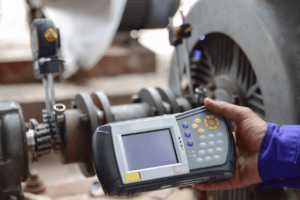 Maintenance is essential to keep every mechanical device working at peak efficiency. As a result, predictive maintenance has become the industry standard as companies strive to reduce operating costs while minimizing downtime and unplanned repairs.
Maintenance is essential to keep every mechanical device working at peak efficiency. As a result, predictive maintenance has become the industry standard as companies strive to reduce operating costs while minimizing downtime and unplanned repairs.
With most of the attention devoted to clearances, tolerances, and obvious signs of wear and tear, it’s easy to overlook one of the biggest culprits of downtime and production loss, misaligned shafts.
Did you know that misaligned shafts are responsible for nearly 50% of all motor or pump repairs or replacements?
Today, we’ll discuss the importance of shaft alignment as part of your predictive maintenance schedule.
Predictive (Preventative) Maintenance and Role of Precise Shaft Alignment
While motors, pulleys, driven devices, and pumps garner most of the attention during preventative maintenance chores, all these components rely on shafts to transfer power throughout your system.
Misaligned shafts are typically responsible for damage to seals and bearings but can also lead to:
- Increased friction at connection points
- Loss of performance and efficiency
- Excessive wear on couplings, connections, belts, and pulleys
- Increased vibration
- Increased noise levels
- Excessive heat build up
- Lubricant leakage
- Premature shaft failure
Any of these issues can quickly turn into unexpected downtime and costly repairs for your business. As a result, shaft alignment should be a critical part of your predictive maintenance plan.
How Shaft Alignment Affects Electric Motor Reliability
With the shaft alignment correctly set, the electric motor can work at peak performance and efficiency over its lifecycle. But a precision shaft alignment can also…
Reduce energy consumption – proper shaft alignment can reduce your energy usage by up to 10%, month after month.
Reduce repairs and costs – with a precision alignment, seal failure declines by up to 65%, and can provide up to 30% reduction in the number of needed repairs.
Extend mechanical life – the more precise the shaft alignment, the longer the lifecycle for your seals, bearings, connectors, pumps, indirect drives, and pullies.
Shaft alignment should be checked regularly and corrected immediately upon discovery. Even the slightest misalignment can cause detrimental stress to the electric motor and any connected devices. If left uncorrected, shaft misalignment can lead to permanent damage or catastrophic failure for your electric motor.
Types of Shaft Alignment
The results of a shaft alignment inspection will fall into one of five categories:
Parallel misalignment (sometimes called offset alignment) can occur when two shaft centerlines are parallel but not in the same line. The result is horizontal or vertical offsets created by shafts displaced left or right of each other, positioned at different vertical elevations, or both.
Angular misalignment occurs when the motor is at an angle to the driven equipment. For example, instead of sharing a common centerline, a difference in slope can create a misalignment vertically, horizontally, or both. Angular misalignment is especially harmful to the electric motor and the driven equipment.
Combination misalignment is when the shaft has experienced angular and parallel misalignment simultaneously.
Axial misalignment can be especially problematic for coupled shaft assemblies. Operational factors such as thermal growth and thrust forces from connected equipment can change the axial position over time. The greater the torque and speed, the more critical the shaft alignment becomes.
The desired result is an ideal alignment with the shaft correctly installed, following all manufacturer recommendations, tolerances, and industry standards (best practices). Regular shaft alignment reduces friction and energy usage while improving performance and equipment lifecycles.
Correcting Shaft Misalignments
While dial indicators are superior to a visual inspection and straightedge test, they require a high level of technical expertise and don’t provide real-time values to help techs measure and simultaneously adjust shaft alignment. And, since they must be removed and reinstalled after each adjustment, obtaining the needed critical measurements can be labor-intensive.
Hi-Speed strongly recommends using a laser shaft alignment process to obtain the most accurate results quickly and easily. Most laser alignment options use two (sometimes more) sending/receiving units. Once the laser sensors are in place (on two or more connected shafts) and turned on, comparing the beams will indicate any misalignment or tolerance issues.
Conclusion
Shaft alignment checks should be a part of your predictive maintenance plan, as they can help prevent unplanned downtime while lowering costs. You can eliminate excessive wear and tear or expensive system breakdowns by eliminating overheating, excessive energy use, and vibration associated with misaligned shafts.
Contact us today with your questions about shaft maintenance or laser shaft alignment. With over 75 years of solving problems before they become problems, the Hi-Speed Team is ready to help!

